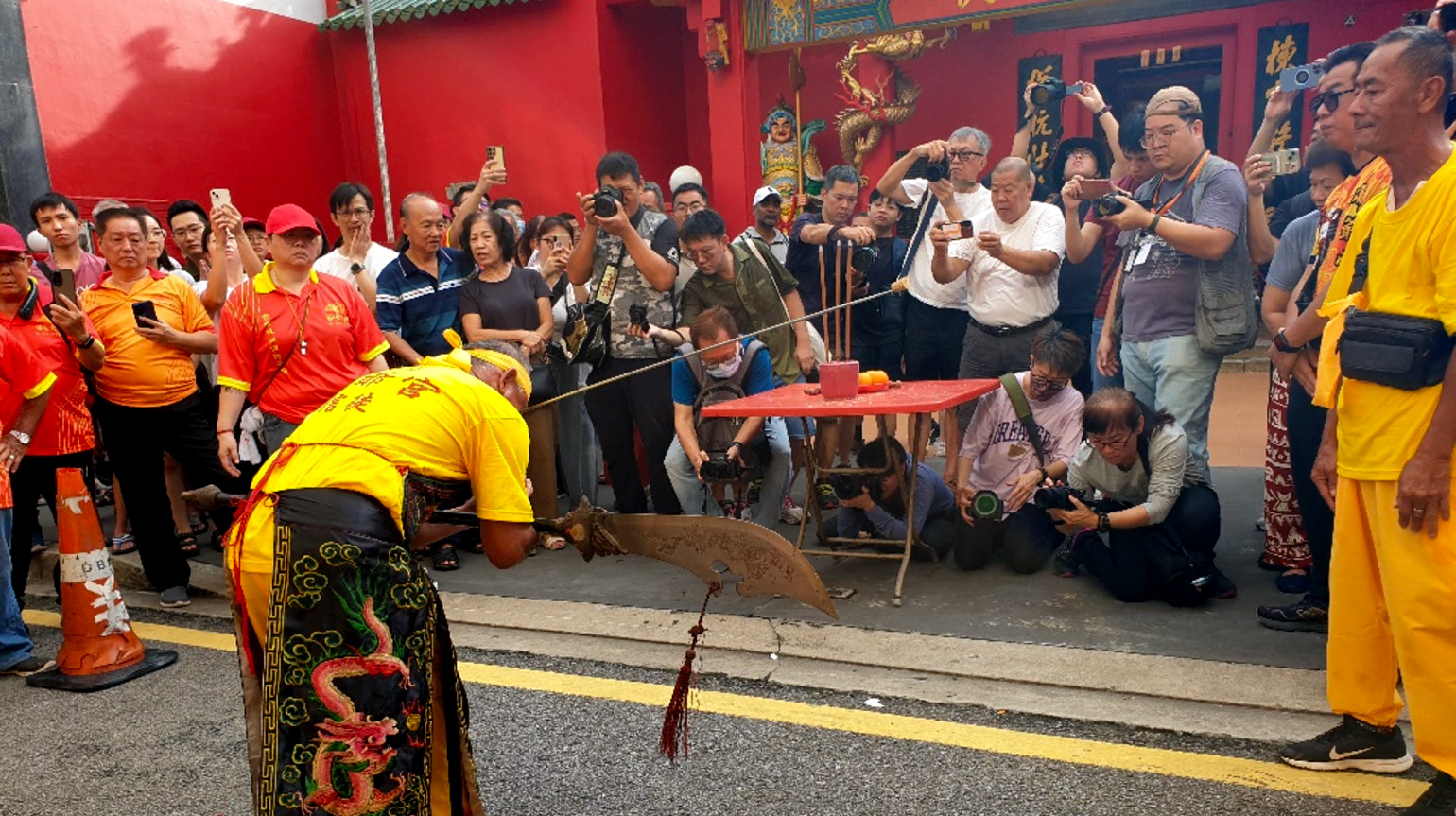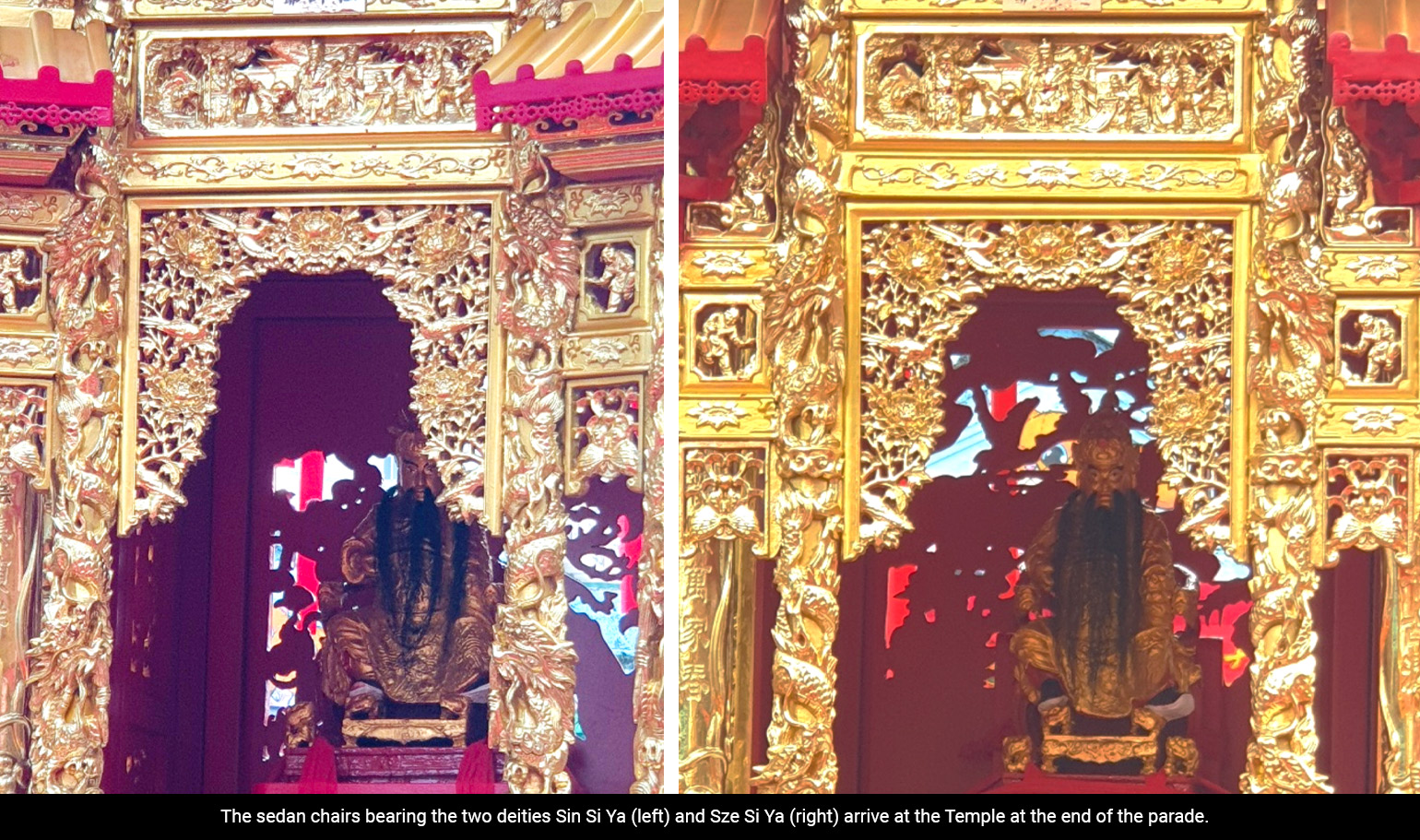To mark its 160th anniversary, the Sin Sze Si Ya Temple (仙四師爺廟) in KL’s Chinatown held two historic events from Saturday 26 to Monday 28 October 2024 – the Grand Prayer Session (Qi An Da Jiao; 齐安大醮) and a spectacular religious parade (You Shen; 游神) through Chinatown.
Newsletter
Iconic Sin Sze Si Ya Temple revives two historic events

The Grand Prayer Session (Qi An Da Jiao; 齐安大醮)
Over 3 days, worshippers and devotees thronged the temple to participate in prayer ceremonies and rituals and make donations aimed at bringing blessings, peace and prosperity to themselves and their families. This revered event was revived by the temple after an absence of 76 years.



A temple official writes out a text for a mother with the wish that “Lord Wen Chang will bless [the son] with good results in the exam”. Wen Chang Di Jun (文昌帝君) is the Daoist deity associated with literature, education and scholarly pursuits usually worshipped by students and scholars seeking success in their studies, particularly during exams.

This is custom heading element
In Daoist ritual, Li Dou (禮斗) refers to offerings, prayers or chants to honour deities, ancestors and the natural world, seeking to align oneself with the Dao (the Way).
For the Grand Prayer Session and to mark its 160th anniversary, the Sin Sze Si Ya Temple created exquisite Li Dou wooden carved containers for devotees to ward off evil spirits and bless them and their families with longevity.
Li Dou is an important method of fundraising for the Temple. Large numbers of Li Dou were taken up by devotees who are keen to support the temple’s widely respected charity contributions to education and other community causes.
The Li Dou contains numerous items, each bearing a signification:
- Precious umbrella – to protect and safeguard one’s life
- Dou qian – writing information
- Lamp – to illuminate a bright future
- Rice – abundance of the Five Grains (五谷, wu gu), the five staple crops in food and agriculture (rice, wheat, millet, barley, sorghum)
- Weighing scale – prosperity in business and fairness in conduct of affairs
- Brush – proficiency in writing
- Sword – demolishing evil
- Ruler – rise to prominence
- Mirror – harmony and peace in relationships
- Red thread – support from nobleman for a long duration
- Scissors – cutting off inauspicious things
- Sun umbrella – inviting wealth from afar
- Moon umbrella – fortune coming from afar.


The scale has three parts: a pan affixed to a pointer-fulcrum, a wooden rod engraved with weight marks at the top, and a lead counterweight. The tradesman places the item on the pan; he holds the scale by a string with one hand, while with the other hand he slides the string holding the counterweight along the rod until the pointer-fulcrum are aligned. Where the string rests on the weight mark on the rod, it indicates the weight of the item and its cost is calculated accordingly. Conversely, if 1 catty of an item is requested by the customer, the tradesman will locate the string of the counterweight at the 1 catty mark on the rod and the precise quantity of the item is added to the pan until the pointer-fulcrum align with each other. (The catty is a traditional Chinese measure of weight, equivalent to about 1¼ lbs).
The Chinese weighing scale dates from 200 BC and was an essential aspect of commerce and trade throuhhout China and the diaspora. It has declined in importance with the universal changeover to the metric system and the emergence of spring and electronic scales, although trades like Chinese traditional medicine and jewellers still swear by it for its precision and durability.

The Religious Parade (You Shen; 游神)
The highlight of the 160th anniversary celebration of the Sin Sze Si Ya Temple was a grand religious parade (You Shen; 游神) through the streets of Chinatown on the morning of Sunday 27 October. It was a historic revival after an absence of 63 years.
The Parade in Pictures

















Lions pay their respects at the Guan Di Temple, located in Jalan Tun HS Lee. The temple is dedicated to Guan Di or Guan Gong, the God of War, a deity who protects people from evil spirits. He was a legendary soldier and friend of Liu Bei and Zhang Fei in the Three Kingdoms era.

A devotee bearing a guan dao (关刀) pays obeisance at Guan Di Temple. The guan dao is a traditional Chinese pole weapon, often referred to as a ‘halberd’ or ‘winged spear’. It typically features a curved blade on a long shaft, resembling a combination of a spear and a sword. It was used by infantry in battle and is associated with various Chinese martial arts.





New friends: on the eve of the parade, we were privileged to meet Ms Tan Huck Hong and Sifu Gan at the Temple. Ms Tan is well versed in the ways of Daoism; she is currently compiling a directory of Chinese temples in Malaysia, and the project is now in its thirteenth year. Sifu Gan is a Daoist priest who came from Johor to lend his expertise to the organisation of the historic event.
Sources: https://chinamarketadvisor.com; https://www.holidify.com/places/kuala-lumpur/sin-sze-si-ya-temple-sightseeing-1259696.html; Wikipedia; https://www.malaysian-nomad.asia/2017/05/sin-sze-si-ya-temple-kuala-lumpur.html
Acknowledgements: Mr Lai Sin Siang; Ms Tan Huck Hong; Ms Foo Hui Ni

